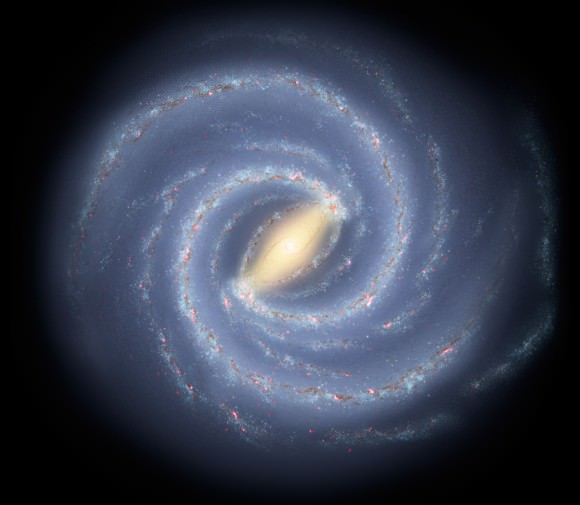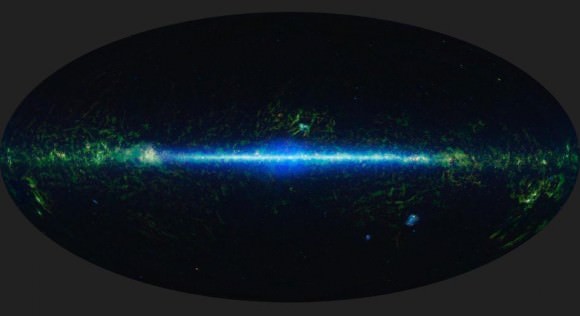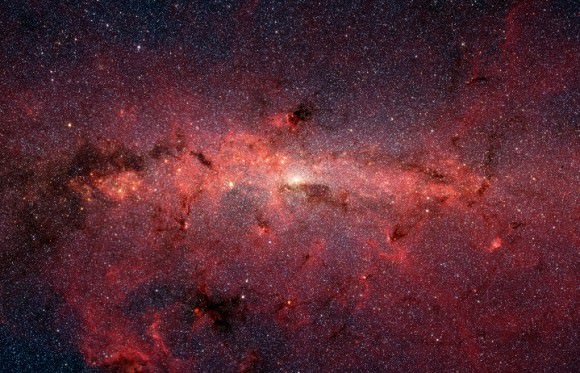When you look up into the night sky, it seems like you can see a lot of stars. There are about 2,500 stars visible to the naked eye at any one point in time on the Earth, and 5,800-8,000 total visible stars (i.e. that can be spotted with the aid of binoculars or a telescope). But this is a very tiny fraction of the stars the Milky Way is thought to have!
So the question is, then, exactly how many stars are in the Milky Way Galaxy? Astronomers estimate that there are 100 billion to 400 billion stars contained within our galaxy, though some estimate claim there may be as many as a trillion. The reason for the disparity is because we have a hard time viewing the galaxy, and there’s only so many stars we can be sure are there.
Structure of the Milky Way:
Why can we only see so few of these stars? Well, for starters, our Solar System is located within the disk of the Milky Way, which is a barred spiral galaxy approximately 100,000 light years across. In addition, we are about 30,000 light years from the galactic center, which means there is a lot of distance – and a LOT of stars – between us and the other side of the galaxy.

To complicate matter further, when astronomers look out at all of these stars, even closer ones that are relatively bright can be washed out by the light of brighter stars behind them. And then there are the faint stars that are at a significant distance from us, but which elude conventional detection because their light source is drowned out by brighter stars or star clusters in their vicinity.
The furthest stars that you can see with your naked eye (with a couple of exceptions) are about 1000 light years away. There are quite a few bright stars in the Milky Way, but clouds of dust and gas – especially those that lie at the galactic center – block visible light. This cloud, which appears as a dim glowing band arching across the night sky – is where our galaxy gets the “milky” in its name from.
It is also the reason why we can only really see the stars in our vicinity, and why those on the other side of the galaxy are hidden from us. To put it all in perspective, imagine you are standing in a very large, very crowded room, and are stuck in the far corner. If someone were to ask you, “how many people are there in here?”, you would have a hard time giving them an accurate figure.
Now imagine that someone brings in a smoke machine and begins filling the center of the room with a thick haze. Not only does it become difficult to see clearly more than a few meters in front of you, but objects on the other side of the room are entirely obscured. Basically, your inability to rise above the crowd and count heads means that you are stuck either making guesses, or estimating based on those that you can see.

Imaging Methods:
Infrared (heat-sensitive) cameras like the Cosmic Background Explorer (aka. COBE) can see through the gas and dust because infrared light travels through it. And there’s also the Spitzer Space Telescope, an infrared space observatory launched by NASA in 2003; the Wide-field Infrared Survey Explorer (WISE), deployed in 2009; and the Herschel Space Observatory, a European Space Agency mission with important NASA participation.
All of these telescopes have been deployed over the past few years for the purpose of examining the universe in the infrared wavelength, so that astronomers will be able to detect stars that might have otherwise gone unnoticed. To give you a sense of what this might look like, check out the infrared image below, which was taken by COBE on Jan. 30th, 2000.
However, given that we still can’t seem them all, astronomers are forced to calculate the likely number of stars in the Milky Way based on a number of observable phenomena. They begin by observing the orbit of stars in the Milky Way’s disk to obtain the orbital velocity and rotational period of the Milky Way itself.
Estimates:
From what they have observed, astronomers have estimated that the galaxy’s rotational period (i.e. how long it takes to complete a single rotation) is apparently 225-250 million years at the position of the Sun. This means that the Milky Way as a whole is moving at a velocity of approximately 600 km per second, with respect to extragalactic frames of reference.

Then, after determining the mass (and subtracting out the halo of dark matter that makes up over 90% of the mass of the Milky Way), astronomers use surveys of the masses and types of stars in the galaxy to come up with an average mass. From all of this, they have obtained the estimate of 200-400 billion stars, though (as stated already) some believe there’s more.
Someday, our imaging techniques may become sophisticated enough that are able to spot every single star through the dust and particles that permeate our galaxy. Or perhaps will be able to send out space probes that will be able to take pictures of the Milky Way from Galactic north – i.e. the spot directly above the center of the Milky Way.
Until that time, estimates and a great deal of math are our only recourse for knowing exactly how crowded our local neighborhood is!
We have written many great articles on the Milky Way here at Universe Today. For example, here are 10 Facts About the Milky Way, as well as articles that answer other important questions.
These include How Big Is The Milky Way?, What is the Milky Way?, and Why Is Our Galaxy Called the Milky Way?
Astronomy Cast did a podcast all about the Milky Way, and the Students for the Exploration and Development of Space (SEDS) have plenty of information about the Milky Way here.
And if you’re up for counting a few of the stars, check out this mosaic from NASA’s Astronomy Picture of the Day. For a more in-depth explanation on the subject, go to How the Milky Way Galaxy Works.

